I recently saw this question on how to rotate an image in Java. I copy/pasted it directly from that answer. On implementation, it seems to only rotate images that are squares(that is have the same size, width and height). When I try to use it for a non-square image, it seems to cut off that part that would make it be a rectangle, if that makes sense. Like this

How can I fix/work around this?
Edit: The code I'm using. Also, I won't have a scroll bar as this will be a "game", and also won't be in full screen all of the time.
public class Player extends Entity { //Entity has basic values such as (float) x & y values, along with some getters and setters
double theta;
Reticle reticle; //draws a reticle where the cursor was(basically just replaces java.awt.Cursor due to something not neccessary for me to get into)
Sprite currentImage; //basically just a BufferedImage that you can apply aspect ratios to
//constructor
@Override
public void tick() {
//(this line) gets the Reticle from the main-method class and set it to this reticle object
reticleX = reticle.getX(); //basically gets the mouse coordinates
reticleY = reticle.getY();
x += dX; //delta or change in X
y += dY //delta or change in Y
checkCollision(); //bounds checking
//getCentralizedX()/Y() gets the center of the currentImage
theta = getAngle(getCentralizedX(), getCentralizedY(), reticleX, reticleY);
currentImage = Images.rotateSprite(currentImage, theta);
}
@Override
public void render(Graphics g) {
currentImage.render(g, x, y);
g.drawLine((int) getCentralizedX(), (int) getCentralizedY(), (int) reticleX, (int) reticleY);
}
public double getAngle(float startX, float startY, float goalX, float goalY) {
double angle = Math.atan2(goalY - startY, goalX - startX);
//if(angle < 0) { //removed this as this was the thing messing up the rotation
//angle += 360;
//}
}
If the angle of the soldier is from 90 < angle < 270, then it is (basically), however, if its its 90 > angle > 270, then it gets a little wonky. Here are some pictures. It is not the angle of the aim-line(the blue line) that is wrong.
Removed all of the images as removing the if(angle < 0) inside of getAngle() fixed the rotation bug. Now the only problem is that it doesn't rotate in place.
EDIT 2: My SSCCE, which uses the same method as my game, but freaks out for some reason.
public class RotateEx extends Canvas implements Runnable {
Player player;
public RotateEx(BufferedImage image) {
player = new Player(image, 50, 50);
setPreferredSize(new Dimension(600, 600));
}
public void setDegrees(int degrees) {
player.theta = Math.toRadians(degrees);
}
public BufferedImage rotateImage(BufferedImage original, double theta) {
double cos = Math.abs(Math.cos(theta));
double sin = Math.abs(Math.sin(theta));
double width = original.getWidth();
double height = original.getHeight();
int w = (int) (width * cos + height * sin);
int h = (int) (width * sin + height * cos);
BufferedImage out = new BufferedImage(w, h, original.getType());
Graphics2D g2 = out.createGraphics();
double x = w / 2; //the middle of the two new values
double y = h / 2;
AffineTransform at = AffineTransform.getRotateInstance(theta, x, y);
x = (w - width) / 2;
y = (h - height) / 2;
at.translate(x, y);
g2.drawRenderedImage(original, at);
g2.dispose();
return out;
}
public void tick() {
player.tick();
}
public void render() {
BufferStrategy bs = this.getBufferStrategy();
if(bs == null) {
createBufferStrategy(4);
return;
}
Graphics g = bs.getDrawGraphics();
g.setColor(Color.WHITE);
g.fillRect(0, 0, getWidth(), getHeight());
player.render(g);
g.dispose();
bs.show();
}
public static void main(String args[]) throws IOException, InterruptedException {
String loc = "FILELOCATION"; //of course this would be a valid image file
BufferedImage image = ImageIO.read(new File(loc));
final RotateEx ex = new RotateEx(image);
final JSlider slider = new JSlider(JSlider.HORIZONTAL, 0, 360, 0);
slider.addChangeListener(new ChangeListener() {
@Override
public void stateChanged(ChangeEvent e) {
int value = slider.getValue();
ex.setDegrees(value);
}
});
JFrame f = new JFrame();
f.setDefaultCloseOperation(JFrame.EXIT_ON_CLOSE);
f.add(ex);
f.add(slider, BorderLayout.SOUTH);
f.pack();
f.setLocationRelativeTo(null);
f.setVisible(true);
new Thread(ex).start();
}
@Override
public void run() {
long lastTime = System.nanoTime();
final double numTicks = 60.0;
double n = 1000000000 / numTicks;
double delta = 0;
int frames = 0;
int ticks = 0;
long timer = System.currentTimeMillis();
while (true) {
long currentTime = System.nanoTime();
delta += (currentTime - lastTime) / n;
lastTime = currentTime;
render();
tick();
frames++;
if (delta >= 1) {
ticks++;
delta--;
}
}
}
class Player {
public float x, y;
int width, height;
public double theta; //how much to rotate, in radians
BufferedImage currentImage; //this image would change, according to the animation and what frame its on
public Player(BufferedImage image, float x, float y) {
this.x = x;
this.y = y;
width = image.getWidth();
height = image.getHeight();
currentImage = image;
}
public void tick() {
currentImage = rotateImage(currentImage, theta);
}
public void render(Graphics g) {
g.drawImage(currentImage, (int) x, (int) y, null);
}
}
}